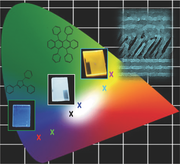Youssef Oulad-Zian, Juan Ramon Sanchez-Valencia, Manuel Oliva.Ramirez, Julian Parra-Barranco, Maria Alcaire, Francisco J. Aparicio, Ana Mora-Boza, Juan Pedro Espinos, Francisco Yubero, Agustin R. Gonzalez-Elipe, Angel Barranco and Ana Borras
Advanced Optical Materials, 4 (2016) 1124–1131

This study shows the fabrication by a dry approach at mild temperature (<150 °C) of a photoluminescence white light emitting hybrid layer. The white light emitter is obtained by evaporation of two photoluminescent small molecules, a blue (1,3,5-triphenyl-2-pyrazoline (TPP)) and an orange (Rubrene) dye within the porous of an SiO 2 host fi lm fabricated by glancing angle deposition. Fluorescence (Föster) resonant energy transfer between the two organic dyes allows the emission of the combined system upon excitation of the TPP molecule at wavelength of 365 nm. The distribution of the organic molecule within the host layer is analyzed as a function of the substrate temperature and vacuum conditions and the required conditions for the white emission determined by fi nely controlling the TPP:Rubrene ratio. The full vacuum processing of the hybrid layers provides a straightforward route for the incorporation of the white light emitters as optical defect within 1D Bragg microcavities. As a consequence, directional emission of the system is achieved which allows the development of wide-range in situ tunable photoluminescent devices.

